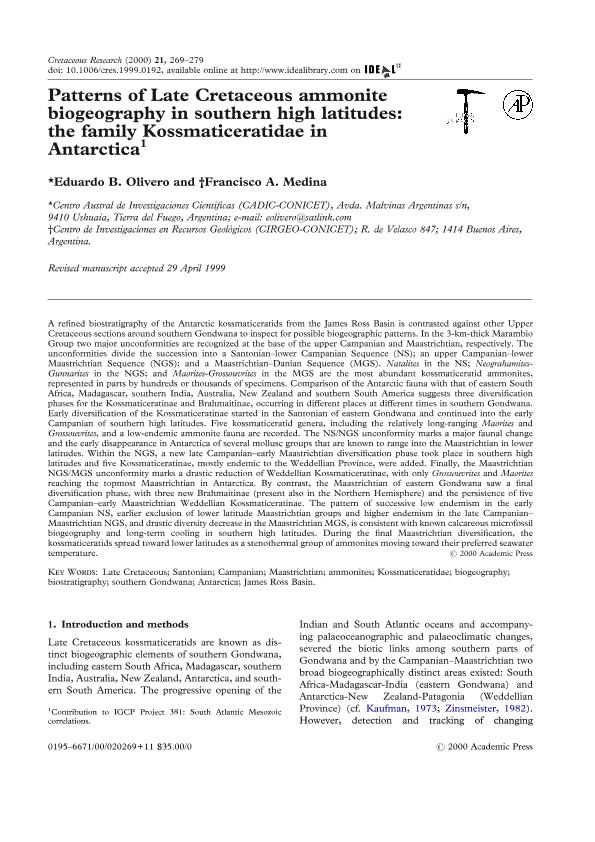Mostrar el registro sencillo del ítem
dc.contributor.author
Olivero, Eduardo Bernardo

dc.contributor.author
Medina, Francisco Alberto

dc.date.available
2020-01-16T20:37:16Z
dc.date.issued
2000-01
dc.identifier.citation
Olivero, Eduardo Bernardo; Medina, Francisco Alberto; Patterns of Late Cretaceous ammonite biogeography in southern high latitudes: The family Kossmaticeratidae in Antarctica; Academic Press Ltd - Elsevier Science Ltd; Cretaceous Research; 21; 2-3; 1-2000; 269-279
dc.identifier.issn
0195-6671
dc.identifier.uri
http://hdl.handle.net/11336/94988
dc.description.abstract
A refined biostratigraphy of the Antarctic kossmaticeratids from the James Ross Basin is contrasted against other Upper Cretaceous sections around southern Gondwana to inspect for possible biogeographic patterns. In the 3-km-thick Marambio Group two major unconformities are recognized at the base of the upper Campanian and Maastrichtian, respectively. The unconformities divide the succession into a Santonian-lower Campanian Sequence (NS); an upper Campanian-lower Maastrichtian Sequence (NGS); and a Maastrichtian-Danian Sequence (MGS). Natalites in the NS; Neograhamites-Gunnarites in the NGS; and Maorites-Grossouvrites in the MGS are the most abundant kossmaticeratid ammonites, represented in parts by hundreds or thousands of specimens. Comparison of the Antarctic fauna with that of eastern South Africa, Madagascar, southern India, Australia, New Zealand and southern South America suggests three diversification phases for the Kossmaticeratinae and Brahmaitinae, occurring in different places at different times in southern Gondwana. Early diversification of the Kossmaticeratinae started in the Santonian of eastern Gondwana and continued into the early Campanian of southern high latitudes. Five kossmaticeratid genera, including the relatively long-ranging Maorites and Grossouvrites, and a low-endemic ammonite fauna are recorded. The NS/NGS unconformity marks a major faunal change and the early disappearance in Antarctica of several mollusc groups that are known to range into the Maastrichtian in lower latitudes. Within the NGS, a new late Campanian-early Maastrichtian diversification phase took place in southern high latitudes and five Kossmaticeratinae, mostly endemic to the Weddellian Province, were added. Finally, the Maastrichtian NGS/MGS unconformity marks a drastic reduction of Weddellian Kossmaticeratinae, with only Grossouvrites and Maorites reaching the topmost Maastrichtian in Antarctica. By contrast, the Maastrichtian of eastern Gondwana saw a final diversification phase, with three new Brahmaitinae (present also in the Northern Hemisphere) and the persistence of five Campanian-early Maastrichtian Weddellian Kossmaticeratinae. The pattern of successive low endemism in the early Campanian NS, earlier exclusion of lower latitude Maastrichtian groups and higher endemism in the late Campanian-Maastrichtian NGS, and drastic diversity decrease in the Maastrichtian MGS, is consistent with known calcareous microfossil biogeography and long-term cooling in southern high latitudes. During the final Maastrichtian diversification, the kossmaticeratids spread toward lower latitudes as a stenothermal group of ammonites moving toward their preferred seawater temperature.
dc.format
application/pdf
dc.language.iso
eng
dc.publisher
Academic Press Ltd - Elsevier Science Ltd

dc.rights
info:eu-repo/semantics/openAccess
dc.rights.uri
https://creativecommons.org/licenses/by-nc-sa/2.5/ar/
dc.subject
AMMONITES
dc.subject
ANTARCTICA
dc.subject
BIOGEOG RAPHY
dc.subject
BIOSTRATIGRAPHY
dc.subject
CAMPANIAN
dc.subject
JAMES ROSS BASIN
dc.subject
KOSSMATICERATIDAE
dc.subject
LATE CRETACEOUS
dc.subject
MAASTRICHTIAN
dc.subject
SANTONIAN
dc.subject
SOUTHERN GONDWANA
dc.subject.classification
Geología

dc.subject.classification
Ciencias de la Tierra y relacionadas con el Medio Ambiente

dc.subject.classification
CIENCIAS NATURALES Y EXACTAS

dc.title
Patterns of Late Cretaceous ammonite biogeography in southern high latitudes: The family Kossmaticeratidae in Antarctica
dc.type
info:eu-repo/semantics/article
dc.type
info:ar-repo/semantics/artículo
dc.type
info:eu-repo/semantics/publishedVersion
dc.date.updated
2020-01-15T19:20:32Z
dc.journal.volume
21
dc.journal.number
2-3
dc.journal.pagination
269-279
dc.journal.pais
Países Bajos

dc.journal.ciudad
Amsterdam
dc.description.fil
Fil: Olivero, Eduardo Bernardo. Consejo Nacional de Investigaciones Científicas y Técnicas. Centro Austral de Investigaciones Científicas; Argentina
dc.description.fil
Fil: Medina, Francisco Alberto. Centro de Investigaciones En Recursos Geológicos; Argentina. Consejo Nacional de Investigaciones Científicas y Técnicas; Argentina
dc.journal.title
Cretaceous Research

dc.relation.alternativeid
info:eu-repo/semantics/altIdentifier/url/https://www.sciencedirect.com/science/article/pii/S0195667199901921
dc.relation.alternativeid
info:eu-repo/semantics/altIdentifier/doi/https://doi.org/10.1006/cres.1999.0192
Archivos asociados
